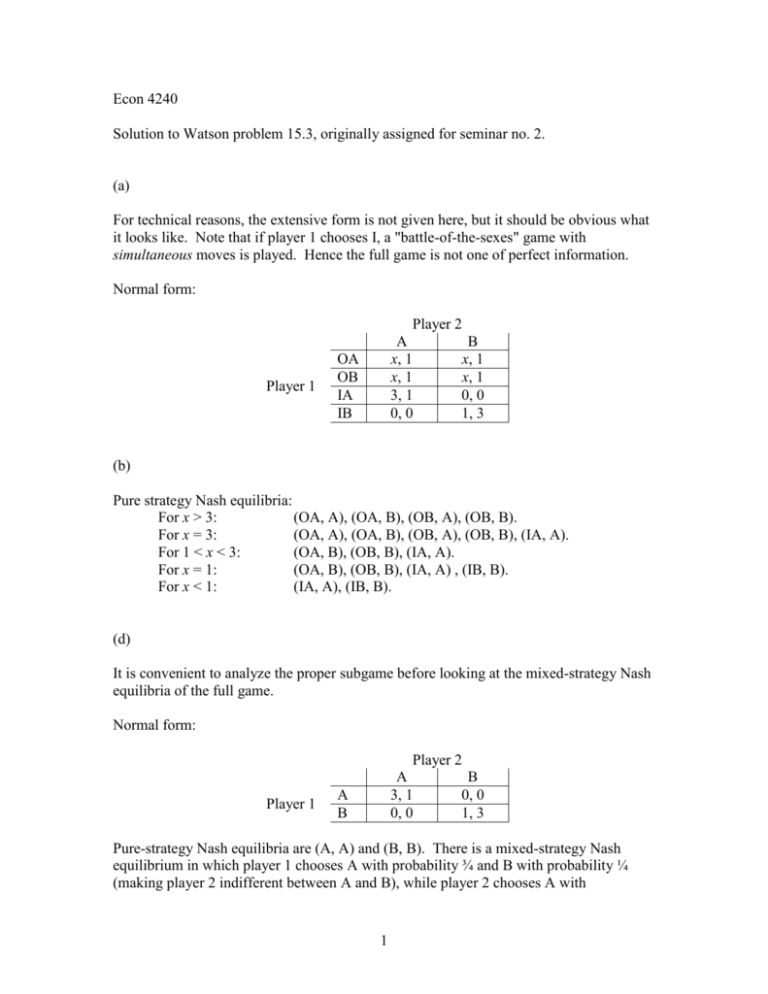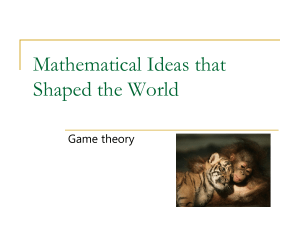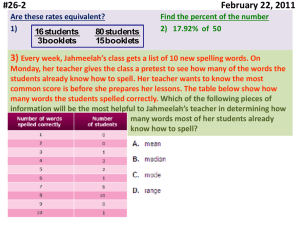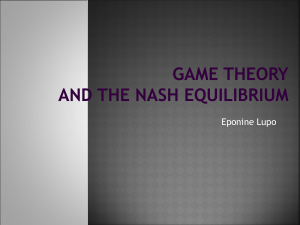Solution to Watson problem 15.3
advertisement

Econ 4240 Solution to Watson problem 15.3, originally assigned for seminar no. 2. (a) For technical reasons, the extensive form is not given here, but it should be obvious what it looks like. Note that if player 1 chooses I, a "battle-of-the-sexes" game with simultaneous moves is played. Hence the full game is not one of perfect information. Normal form: Player 2 Player 1 A x, 1 x, 1 3, 1 0, 0 OA OB IA IB B x, 1 x, 1 0, 0 1, 3 (b) Pure strategy Nash equilibria: For x > 3: (OA, A), (OA, B), (OB, A), (OB, B). For x = 3: (OA, A), (OA, B), (OB, A), (OB, B), (IA, A). For 1 < x < 3: (OA, B), (OB, B), (IA, A). For x = 1: (OA, B), (OB, B), (IA, A) , (IB, B). For x < 1: (IA, A), (IB, B). (d) It is convenient to analyze the proper subgame before looking at the mixed-strategy Nash equilibria of the full game. Normal form: Player 1 Player 2 A B 3, 1 0, 0 0, 0 1, 3 A B Pure-strategy Nash equilibria are (A, A) and (B, B). There is a mixed-strategy Nash equilibrium in which player 1 chooses A with probability ¾ and B with probability ¼ (making player 2 indifferent between A and B), while player 2 chooses A with 1 probability ¼ and B with probability ¾ (making player 1 indifferent between A and B). (c) Though not conceptually difficult, this question turned out to be quite complicated, since many different cases must be considered. Denote by pOA the probability put by player 1 on strategy OA, etc. The numbers pOA, pOB, pIA and pIB are non-negative and sum to 1. Denote by q the probability put by player 2 on strategy A, so that B is played with probability 1 - q. Here 0 ≤ q ≤ 1. If player 2 chooses a genuinely mixed strategy, that is, 0 < q < 1, player 2 must be indifferent between A and B. This requires pOA + pOB + pIA = pOA + pOB + 3pIB or pIA = 3pIB. In particular, if one of the numbers pIA and pIB is 0, so is the other one. If x > 3, IA and IB are dominated. In equilibrium, therefore, pIA = pIB = 0. Any nonnegative pOA and pOB summing to 1, and any admissible q, constitute an equilibrium. If x = 3, IB is dominated and in equilibrium we must have pIB = 0. If pIA > 0, then A is the unique best response for player 2. As for the case x > 3, any non-negative pOA and pOB summing to 1, and any admissible q, constitute an equilibrium. In addition, there is a class of equilibria where pIA > 0, pIB = 0 and q = 1. (Here pOA and pOB are arbitrary, subject to probabilities being non-negative and pOA + pOB + pIA = 1.) If 1 < x < 3, IB is dominated and in equilibrium we must have pIB = 0. If pIA > 0, then A is the unique best response for player 2. If player 2 chooses A with certainty, that is, if q = 1, IA is the unique best response for player 1. Hence there exists no equilibrium with pIA > 0, except the pure-strategy equilibrium (IA, A). Any probability mixture of OA and OB makes player 2 indifferent between A and B. If player 2 chooses q ≤ x/3, then OA and OB are both best responses for player 1. (The expected outcome for player 1 of choosing OA or OB is x, while it is 3q ≤ x for IA.) Thus we have identified a class of mixed-strategy Nash equilibria, where pOA and pOB are arbitrary non-negative numbers summing to 1 and q ≤ x/3. (If q > x/3, the unique best response for player 1 is IA, and we get no mixed-strategy equilibrium.) If x = 1, the equilibria identified above for the case 1 < x < 3 still apply. To see if there are other equilibria, first assume q = 1. Then IA is the unique best response for player 1, and we get no mixed-strategy equilibrium. For 0 < q < 1, IB is not a best response for player 1. Hence pIB = 0, which implies pIA = 0 when 0 < q < 1. Then we are back in the class of equilibria already mentioned. There remains the possibility q = 0. We get a class of equilibria with pIA = 0, that is, player 1 mixes among OA, OB and IB, while player 2 uses the pure strategy B. Then assume ¾ < x < 1. If q = 1, IA is the unique best response for player 1. If q = 0, IB is the unique best 2 response for player 1. In these cases, we get no mixed-strategy equilibrium. Hence we can restrict attention to player 2 choosing a genuinely mixed strategy, that is, 0 < q < 1. If q < 1 - x, IB is the unique best response for player 1. If q > x/3, IA is the unique best response for player 1. Remembering that 0 < q < 1 requires pIA = 3pIB, we conclude that there can be no mixed-strategy Nash equilibrium in these cases. If 1 - x < q < x/3, OA and OB are best responses for player 1. If q = 1 - x, OA, OB and IB are best responses for player 1. Since IA is not a best response, pIA = 0, implying pIB = 0. If q = x/3, OA, OB and IA are best responses for player 1. Since IB is not a best response, pIB = 0, implying pIA = 0. Hence the mixed-strategy Nash equilibria are characterized by pOA and pOB being arbitrary non-negative numbers summing to 1 and 1 - x ≤ q ≤ x/3. The interval for q is never empty, since it always contains ¼. If x = ¾, the unique best response for player 1 is IA if q > ¼ and IB if q < ¼. Since 0 < q < 1 requires pIA = 3pIB, neither of these cases admits a mixed-strategy Nash equilibrium. If q = ¼, the expected outcome for player 1 is ¾ for all four strategies. Hence q = ¼ combined with any mixed strategy for player 1 satisfying pIA = 3pIB makes op a mixedstrategy Nash equilibrium. If x < ¾, OA and OB are dominated. For example, they are dominated by the mixed strategy given by pIA = ¼, pIB = ¾. It follows that for no value of q can OA or OB be a best response for player 1. In equilibrium, therefore, pOA = pOB = 0. Hence the full game reduces to a game equivalent to the subgame considered in (d). There is one mixedstrategy Nash equilibrium, given by pOA = pOB = 0, pIA = ¾, pIB = ¼, and q = ¼. (e) Among the pure-strategy Nash equilibria listed in (b) for various values of x, (OA, B) and (OB, A) are not perfect, since they in the subgame prescribe behavior which is not an equilibrium in that game. (f) The only mixed-strategy Nash equilibrium in the subgame has q = ¼. Hence q = ¼ in any mixed-strategy subgame perfect Nash equilibrium of the full game. In addition, in any mixed-strategy subgame perfect Nash equilibrium of the full game, player 1 must choose A with probability ¾ in the subgame. Going through the various cases of (c), we find the following subgame perfect Nash equilibria: For x > ¾: pOA = ¾, pOB = ¼, pIA = pIB = 0, and q = ¼. For x = ¾: pOA = 3pOB, pIA = 3pIB, and q = ¼. For x < ¾: pOA = pOB = 0, pIA = ¾, pIB = ¼, and q = ¼. (In the case x = ¾, pIA = 3pIB is necessary to make player 2 indifferent between A and B. Subgame perfectness requires that player 1 chooses A with probability ¾ in the subgame. Then pOA = 3pOB follows.) 3








